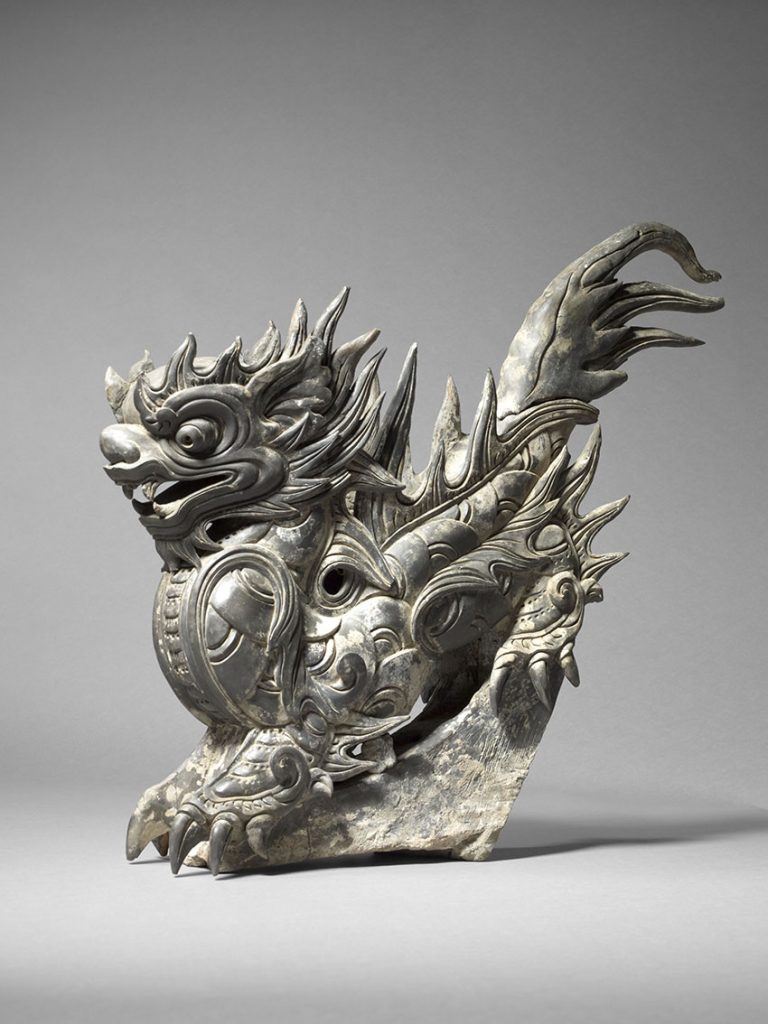AS PART OF the France-Vietnam Year, the Guimet has been showing over the summer an exhibition of works of dragons in Vietnamese art that explores the art and influence of the dragon in Vietnam over the centuries. In Vietnam, the dragon occupies a special position in the country’s art and mythology – often represented as a benign protector.
The Art of the Dragon in Vietnam
For centuries, Vietnamese artists have represented its sinuous line, shaped like a snake. In early history, the Vietnamese dragon was linked to the aquatic world, associated with water, where it is seen as both guardian and provider. The dragon was a vivid symbol of the four-fold deity: clouds, rain, thunder and lighting and was able to influence drought and flooding.
It was a common belief that rain was created by nine dragons, which took water from the sea to pour down onto the rice paddies. The dragon dance was used to invoke rain. Many place names in Vietnam bear the word long (dragon), as in Ha Long Bay (Where the Dragon Descended) or the Cuu Long River (Nine Dragons).
A 1,000 Years of History of Vietnam
The exhibition of dragons in Vietnamese art covers a 1,000 years of this history, from the Bronze Age to the twilight years of the last royal dynasty, through a new selection of works from the National Museum of Vietnamese History in Hanoi and from the Guimet collections.
The exhibition leads the visitor through the developments of an iconography that was frequently associated with royalty and its prestige and includes a number of exceptional works being shown to both French and Vietnamese publics for the first time.
Regalia of the Annam Empire
These include some of the most precious regalia of the Annam Empire: imperial seals and decrees in gold and silver. Like Chinese monarchs, Vietnamese sovereigns chose the dragon as the symbol of their power. But unlike the Chinese dragons, which were shown descending from heaven and spitting fire, the Vietnamese dragons were shown ascending from water. Though imposing and fierce, the Vietnamese dragons were never threatening.
Dragons in Vietnamese Art Appeared From the Bronze Age
The exhibition’s chronological presentation first introduces the visitor to the earliest years of the Bronze Age. Historical scenes on drums and ritual bowls from this period show a fantastic and original bestiary in which the dragon has not yet entirely found its place.
The Chinese domination of the Han era (circa 1st-3rd centuries) illustrates the emergence of representations of the dragon on the splendid funerary furniture found in Vietnamese tombs (in the province of Thanh Hoa), during excavations conducted in the 1920s and 30s by the French School of the Far East under the archeologists Louis Pajot and Olov Janse.
Greatest Variety of Images of Dragons from 10th Century
However, it is in the period following the country’s regained independence, in the 10th century, that Vietnamese art includes the greatest variety of images of dragons in Vietnamese art – it can be found on items of architectural decoration, ceramic masterpieces, or on luxury bronze objects from the 11th to 18th centuries. These works testify to the inventive powers of a country which, although impregnated with Chinese culture, equally demonstrated striking originality.
The dragon took on a whole new appearance with the arrival of the Le dynasty (early 15th to end of 18th centuries). With a raised head, forked horn, wide forehead, prominent nose, large, forceful eyes, five claws, and two splayed feet, a dragon crept up the balustrade of Kinh Thien Hall’s central staircase. This fierce and imposing dragon was clearly a symbol of royal authority. Examples of Le-period dragons can also be found carved in stone in Co Loa Temple and carved in wooden doors in Keo Pagoda, as well as carvings in the royal stone bed in Dinh Temple.
This exhibition of dragons in Vietnamese art also includes a reconstitution of a Buddhist sanctuary with images of dragons among its rich iconography, alongside items of ritual furniture and objects of religious art arranged in an evocative manner. Finally, an exceptional series of masterpieces shown here for the first time illustrate the splendour of the Nguyen dynasty, in Hue, from its founding to the abdication of the last emperor, Bao Dai, on the 25th of August 1945.
Until 15 September at Musée Guimet, 6 Place d’Iena, Paris, www.guimet.fr. Catalogue in French available, Euro 30.

